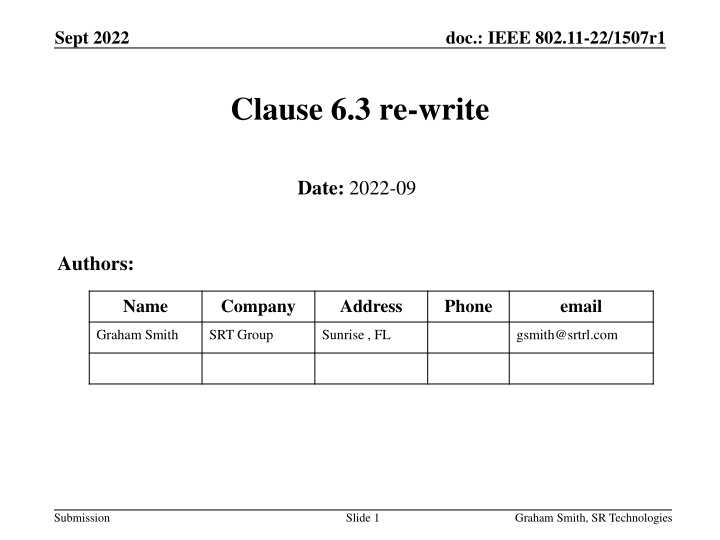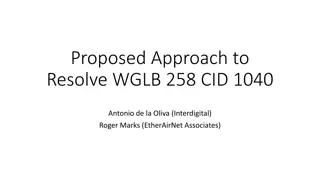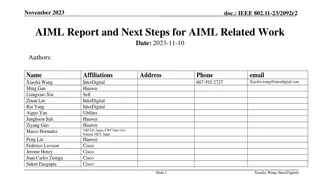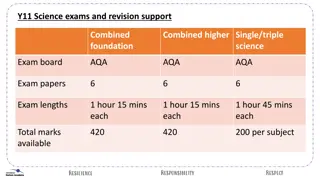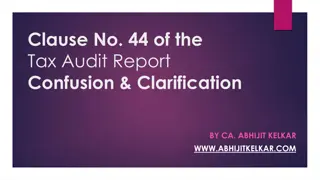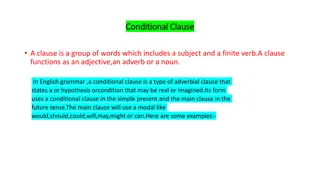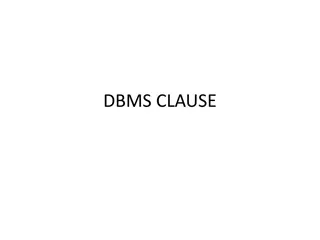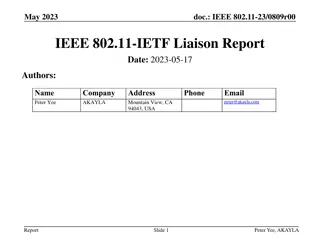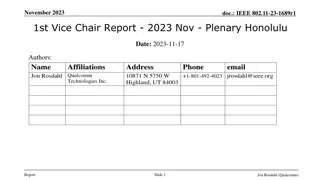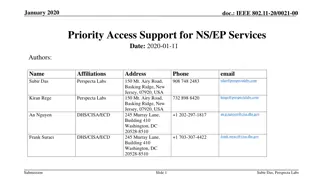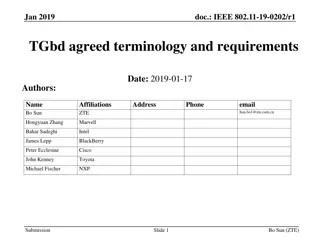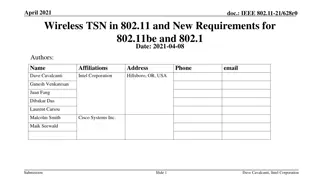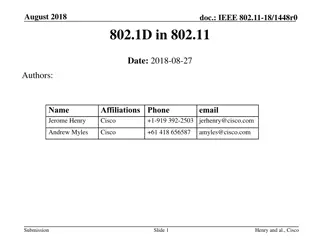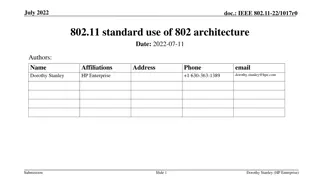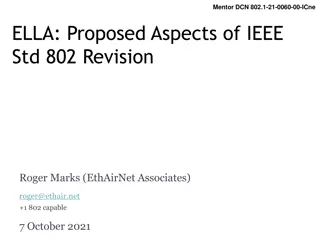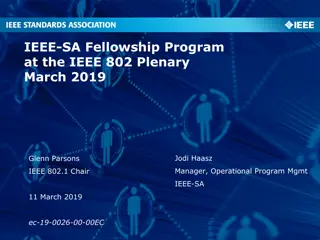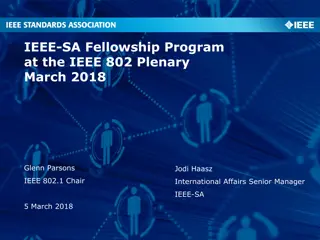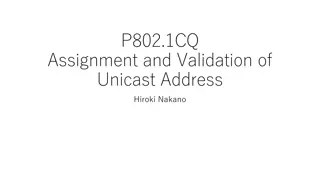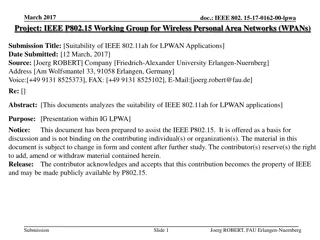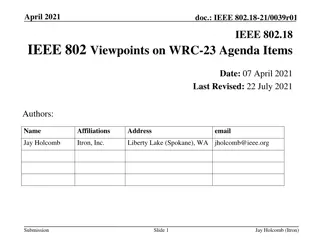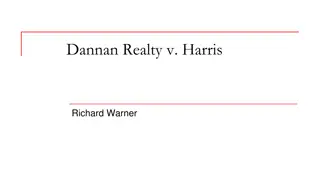IEEE 802.11-22/1507r1 Clause 6.3 Revision Details
In this document related to IEEE 802.11-22/1507r1, Clause 6.3 underwent significant revisions with new text additions for request/response exchanges. The narrative delves into the process of expanding Clause 6, highlighting the complexity and importance of the amendments. The motioned changes have been approved for Draft 1.5, prompting technical groups to focus on the revised Clause 6.3 contents. The recap summarizes the MLME-SAP interface and details the different types of MLME-SAP primitives. Additionally, it explores the significance of various primitive actions within Clause 6.3, emphasizing the abstract descriptions and implementations.
Download Presentation

Please find below an Image/Link to download the presentation.
The content on the website is provided AS IS for your information and personal use only. It may not be sold, licensed, or shared on other websites without obtaining consent from the author.If you encounter any issues during the download, it is possible that the publisher has removed the file from their server.
You are allowed to download the files provided on this website for personal or commercial use, subject to the condition that they are used lawfully. All files are the property of their respective owners.
The content on the website is provided AS IS for your information and personal use only. It may not be sold, licensed, or shared on other websites without obtaining consent from the author.
E N D
Presentation Transcript
Sept 2022 doc.: IEEE 802.11-22/1507r1 Clause 6.3 re-write Date: 2022-09 Authors: Name Company Address Phone email Graham Smith SRT Group Sunrise , FL gsmith@srtrl.com Submission Slide 1 Graham Smith, SR Technologies
Sept 2022 doc.: IEEE 802.11-22/1507r1 Background: In writing some proposed new text for a number of request / response exchanges, I was informed that I needed to add text to Clause 6. I then went through the routine of writing descriptions for each request, plus the response, plus the indication plus the confirm. 10 pages later I started to think. Clause 6 consumes 434 pages MORE THAN Clause 11 (398 pages) !!! am adding, in fact, was obvious from the text and frames, i.e., boilerplate Boy, this must be good stuff, thinks I then I realized that what I A presentation 21/1822 was originally made in ARC ARC members indicated strong support to do something Submission Slide 2 Graham Smith, SR Technologies
Sept 2022 doc.: IEEE 802.11-22/1507r1 Situation TGme has motioned these changes and they are approved for the next Draft 1.5. Hence TGs should now start to look at any 6.3 additions/edits in the light that 6.3 has been completely revised. Submission Slide 3 Graham Smith, SR Technologies
Sept 2022 doc.: IEEE 802.11-22/1507r1 RECAP 6.3 MLME SAP interface imply any particular implementation . These services are described in an abstract way and do not MLME SAP primitives are of the general form ACTION.request primitive, o Initiates request for a procedure ACTION.confirm primitive (for an exchange initiated by the SAP client) o Reports result of request (success?) ACTION.indication primitive o Result of receipt of request for procedure ACTION.response primitive (for an exchange initiated by the MLME) o Initiate transmission of the requested procedure There are 7 different types Submission Slide 4 Graham Smith, SR Technologies
Sept 2022 doc.: IEEE 802.11-22/1507r1 MLME-SAP Types Type 1 request/response Type 4 send a frame (Only 1, TPC request) Type 5 perform a process e.g., activate power save, get TSF Type 2 request only with confirm e.g., disassociate, channel measurement Type 3 request only Type 6 perform a process e.g., set protection QMF policy set Type 7 indicate an event e.g., MIC Failure Often two type 3 used rather than one Type 1 Submission Slide 5 Graham Smith, SR Technologies
Sept 2022 doc.: IEEE 802.11-22/1507r1 In the vast majority of cases the primitives were simply boiler-plate and did not need to be spelled out in all their glory. Straightforward to construct the primitives based upon the descriptions and action frames. BUT Some primitives are not obvious and describe actions that are basic. These tend to be the first ones in 6.3 such as: Authenticate, Associate, Start, Stop, Spectrum management/measurement, SetKeys, Set Protection, Event, DMG Beamforming, Update, etc. Submission Slide 6 Graham Smith, SR Technologies
Sept 2022 doc.: IEEE 802.11-22/1507r1 Work in ARC The work was carried out in the ARC SC over several months and thanks must be made to the participation and contributions of the members, with special mention to Joe Levy Mark Hamilton Journi Malinen Submission Slide 7 Graham Smith, SR Technologies
Sept 2022 doc.: IEEE 802.11-22/1507r1 Adopted method The following Way Forward was adopted Identify the different Types . Constructed a table that provides the MLME-XXX name, Type and gives references. (New Clause 6.4) Identify MLME SAP primitives that are not obvious or have specific content that is not covered well by text. Keep these in full (moved to new Clause 6.5) did not correct or improve the primitives This is important. As each was examined in detail, the choices of the Type(s) used, and content details were found to be arbitrary. Hence, at this stage do not Repair what was 6.3 Changes and comments could be accepted in future ballots. (However, some details in 6.3 that were not, for some reason, in main text, were inserted into the main text where the SG thought important not to lose the Figure or reference.) Submission Slide 8 Graham Smith, SR Technologies
Sept 2022 doc.: IEEE 802.11-22/1507r1 Excerpt from proposed Table 6.4 Submission Slide 9 Graham Smith, SR Technologies
Sept 2022 doc.: IEEE 802.11-22/1507r1 New Text in 22/0916r9 Estimated reduction in pages: 300+ Suggested that experts should look at the primitives in their area(s) and confirm that they are content that the new format works for them. Also, check that the references in the Table are corr Submission Slide 10 Graham Smith, SR Technologies
Sept 2022 doc.: IEEE 802.11-22/1507r1 New Amendments New amendments can simply add a line to the Table in 6.4 for each service Include the correct text references Include references to the primitives in text plus how to and when to use them (no difference to previous) OR They can add to the Table in 6.4 AND insert the full primitives, in all their glory, in 6.5 This change will reduce the work of every TG Submission Slide 11 Graham Smith, SR Technologies
